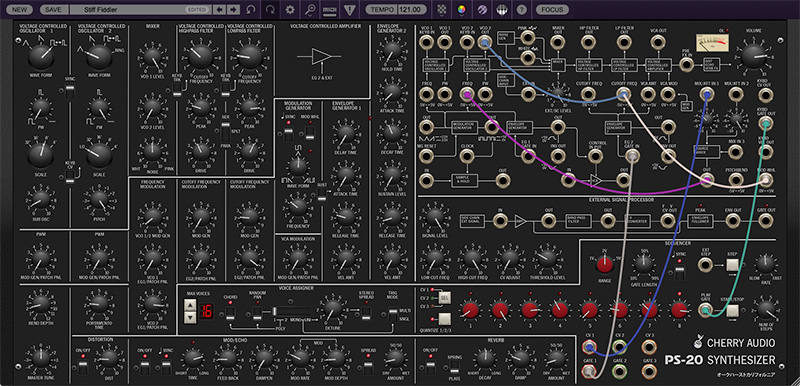
At the most basic level, the original MS-20 has a relatively simple voice architecture: it's a monophonic (one-note-at-a-time) analog synthesizer with two oscillators mixed into highpass and lowpass filters in series (one after the other), then to a VCA, which is controlled by an envelope generator. There's also an additional simple envelope generator that normally modulates the pitch of both oscillators, and an LFO that controls both oscillator pitches and/or filter cutoff frequencies.
The MS-20 is more than just a basic monosynth - its voice architecture can be altered considerably by plugging cables into its semi-normalled patch panel section. In theory, the patch panel is a fantastic addition to an affordable, basic synthesizer, but it's where things get hazy for many users, because the original MS-20 patch panel is a bit confounding, even for experienced modular users. There are a couple of reasons for this:
Connectivity- At a glance, it appears to be a sea of jacks, but in reality, it's missing a lot of the connectivity necessary for serious modular functionality. For example, it lacks audio outputs for each oscillator, and there are no separate inputs for the lowpass and highpass filters.
Terminology- Some of the panel labels are confusing. Gate inputs and outputs are misleadingly labeled Trigger, and most users struggle with the Total modulation input concept.
Although PS-20's patch panel greatly resembles an original an MS-20, if you look closely, you'll see we've seriously altered it from the original. We've eliminated the Total modulation input and its attenuators, added a LOT of additional connectivity, and changed a number of the labels to make it much easier to understand. These changes radically transform its usability. Users with analog modular synth experience should have no trouble jumping right in. Of course, you can learn all about it in the Patch Panel section.
Besides its improved patching abilities, PS-20 also radically differs from the original synth by virtue of up to 16-note polyphony, as opposed to the mono voice structure of the original. This massive increases its musicality (and accounts for the "P" in PS-20).
We've also added a three-level, eight-step sequencer; that is, it's really three separate, synchronized sequencers, each with its own independent pitch and gate settings and outputs. This adds a whole new dimension to patches.
And finally, we've replicated the MS-20's uniquely weird External Signal Processor (ESP) section. The ESP hs the ability to convert monophonic audio signals (routed inside a DAW via sidechaining) into pitch and gate CV signals. The tracking accuracty of the original was somewhat squirrely - we've improved it a bit in PS-20, but this inaccuracy adds to its charm (check out live YouTube vids of Goldfrapp's "Lovely Head" for a mind-blowing demonstration of the original MS-20's ESP section).
Like the MS-20 that inspired it, the PS-20 may not the most straightforward or predictable synthesizer you'll ever encounter, particularly when the filters are screaming away and cutoff frequencies modulated. On the contrary, one often ends up with something different than expected, and herein lies its beauty, as the results are frequently more interesting than the original intention. This is what makes PS-20 so rewarding and fun to play. We hope you enjoy it as much as we have!